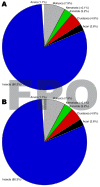Aquatic invertebrates as unlikely vectors of Buruli ulcer disease
- PMID: 18680648
- PMCID: PMC2600397
- DOI: 10.3201/eid1408.071503
Aquatic invertebrates as unlikely vectors of Buruli ulcer disease
Abstract
Buruli ulcer is a necrotizing skin disease caused by Mycobacterium ulcerans and associated with exposure to aquatic habitats. To assess possible transmission of M. ulcerans by aquatic biting insects, we conducted a field examination of biting water bugs (Hemiptera: Naucoridae, Belostomatidae, Nepidae) in 15 disease-endemic and 12 non-disease-endemic areas of Ghana, Africa. From collections of 22,832 invertebrates, we compared composition, abundance, and associated M. ulcerans positivity among sites. Biting hemipterans were rare and represented a small percentage (usually <2%) of invertebrate communities. No significant differences were found in hemipteran abundance or pathogen positivity between disease-endemic and non-disease-endemic sites, and between abundance of biting hemipterans and M. ulcerans positivity. Therefore, although infection through insect bites is possible, little field evidence supports the assumption that biting hemipterans are primary vectors of M. ulcerans.
Figures




References
-
- Asiedu K, Etuaful S. Socioeconomic implications of Buruli ulcer in Ghana: a three-year review. Am J Trop Med Hyg. 1998;59:1015–22. - PubMed
-
- Merritt RW, Benbow ME, Small PLC. Unraveling an emerging disease associated with disturbed aquatic environments: the case of Buruli ulcer. Front Ecol Environ. 2005;3:323–31.
Publication types
MeSH terms
Substances
Grants and funding
LinkOut - more resources
Full Text Sources
